Guinevere
| Guinevere | |
|---|---|
| Matter of Britain character | |
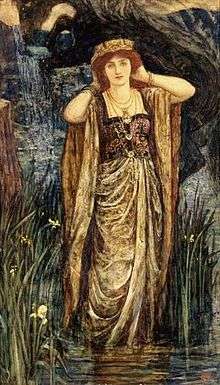 Guinevere by Henry Justice Ford (c. 1910) | |
| First appearance | Historia Regum Britanniae |
| Created by | Geoffrey of Monmouth |
| Information | |
| Occupation | Princess, queen |
| Family |
Leodegrance (father) Gwenhwyfach (sister) |
| Spouse(s) | Arthur |
| Significant other(s) | Mordred, Yder or Lancelot |
Guinevere (/ˈɡwɪnɪvɪər/ (![]()
![]()
Name
The original Welsh form of the name Gwenhwyfar (or Gwenhwyvar), which seems to be cognate with the Irish name Findabair, can be translated as "The White Enchantress" or "The White Fay/Ghost", from Proto-Celtic *Windo- "white, fair, holy" + *sēbarā "magical being" (cognate with Old Irish síabair "a spectre, phantom, supernatural being [usually in pejorative sense]").[2][3][4][5]
Some have suggested that the name may derive from Gwenhwy-fawr, or "Gwenhwy the Great", as a contrast to Gwenhwy-fach, or "Gwenhwy the less". Gwenhwyfach (also spelled Gwenhwyach) appears in Welsh literature as a sister of Gwenhwyfar, but Welsh scholars Melville Richards and Rachel Bromwich both dismiss this etymology (with Richards suggesting that Gwenhwyfach was a back-formation derived from an incorrect interpretation of Gwenwhy-far as Gwenhwy-fawr).[6]
Geoffrey of Monmouth rendered her name as Guanhumara in Latin (though there are many spelling variations found in the various manuscripts of his Historia Regum Britanniae). The name is given as Guennuuar in Caradoc's Vita Gildae, while Gerald of Wales refers to her as Wenneuereia. In the 15th-century Middle Cornish play Bewnans Ke, she was called Gwynnever. A cognate name in Modern English is Jennifer, from Cornish.[7]
Origins, family and characteristics
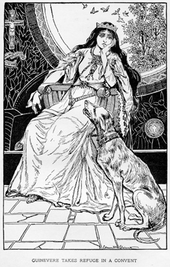
In one of the Welsh Triads (Trioedd Ynys Prydein, no. 56), there are three Gwenhwyfars married to King Arthur. The first is the daughter of Cywryd of Gwent, the second of Gwythyr ap Greidawl, and the third of (G)ogrfan Gawr ("the Giant").[8] In a variant of another Welsh Triad (Trioedd Ynys Prydein, no. 54), only the daughter of Gogfran Gawr is mentioned. Two other Triads (Trioedd Ynys Prydein, no. 53, 84) mention Gwenhwyfar's contention with her sister Gwenhwyfach, which was believed to be the cause of the Battle of Camlann. In the mid-late 12th-century Welsh folktale Culhwch and Olwen, she is mentioned alongside Gwenhwyfach.
In Chrétien de Troyes's Yvain, the Knight of the Lion, she is praised for her intelligence, friendliness, and gentility, while in Marie de France's Lanval (and Thomas Chestre's Middle English version, Sir Launfal), she is a vindictive adulteress, disliked by the protagonist and all well-bred knights. Early chronicles tend to portray her inauspiciously or hardly at all, while later authors use her good and bad qualities to construct a deeper character who played a larger role. The works of Chrétien were some of the first to elaborate on the character Guinevere beyond simply the wife of Arthur. This was likely due to Chrétien's audience at the time, the court of Marie of France, Countess of Champagne, which was composed of courtly ladies who played highly social roles.[9]
Guinevere is childless in most stories,[10] two exceptions being Perlesvaus (the son Loholt) and the Alliterative Morte Arthure.[11] In the latter text, Guinevere willingly becomes Mordred's consort and bears him two sons, though this is implied rather than stated in the text. There were mentions of Arthur's sons in the Welsh Triads, though their exact parentage is not clear.
Other family relations are equally obscure. A half-sister and a brother play the antagonistic roles in the Lancelot–Grail and the German romance Diu Crône respectively, but neither character is mentioned elsewhere. Welsh tradition remembers the queen's sister Gwenhyvach and records the enmity between them. While later literature almost always named Leodegrance as Guinevere's father, her mother was usually unmentioned, although she was sometimes said to be dead; this is the case in the Middle English romance The Awntyrs off Arthure (The Adventures of Arthur), in which the ghost of Guinevere's mother appears to her daughter and Gawain in Inglewood Forest. Other works name cousins of note, though these do not usually appear in more than one place.
There was once a popular folk rhyme known in Wales concerning Gwenhwyfar:
Gwenhwyfar ferch Ogrfan Gawr
Drwg yn fechan, gwaeth yn fawr.
Gwenhwyfar, daughter of Ogrfan Gawr,
Bad when little, worse when great.[12]
In medieval literature
Early appearances
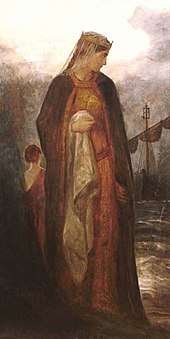
The earliest datable mention of Guinevere (as Guanhumara, with numerous spelling variations in the surviving manuscripts) is in Geoffrey's Historia, written c. 1136. It relates that Guinevere, described as one of the great beauties of Britain, was descended from a noble Roman family and educated under Cador, Duke of Cornwall.[13] Arthur leaves her in the care of his nephew Modredus (Mordred) while he crosses over to Europe to go to war with the Roman leader Lucius Tiberius. While her husband is absent, Guinevere is seduced by Modredus and marries him, and Modredus declares himself king and takes Arthur's throne. Consequently, Arthur returns to Britain and fights Modredus at the fatal Battle of Camlann.[14]
Another early appearance of Guinevere is Culhwch and Olwen, in which she is mentioned as Arthur's wife Gwenhwyfar, but little more is said about her.[15] It can not be securely dated; one recent assessment of the language by linguist Simon Rodway places it in the second half of the 12th century.[16]
Abduction stories
Welsh cleric and author Caradoc of Llancarfan, who wrote his Life of Gildas sometime between 1130-1150,[17] recounts her being kidnapped by Melwas, king of the "Summer Country" (Aestiva Regio, perhaps meaning Somerset), and held prisoner at his stronghold at Glastonbury. The story states that Arthur spent a year searching for her and assembling an army to storm Melwas' fort when Gildas negotiates a peaceful resolution and reunites husband and wife.[18]
A seemingly related account was carved into the archivolt of Modena Cathedral in Italy, which most likely predates Caradoc's telling. Here, Artus de Bretania and Isdernus approach a tower in which Mardoc is holding Winlogee, while on the other side Carrado (most likely Caradoc) fights Galvagin (Gawain) while the knights Galvariun and Che (Sir Kay) approach. Isdernus is most certainly an incarnation of Yder, a Celtic hero whose name appears in Culhwch and Olwen, and who is Guinevere's lover in a nearly-forgotten tradition mentioned in Béroul's 12th-century Tristan and reflected in the later Roman de Yder.
_(14580312508).jpg)
Chrétien de Troyes tells another version of Guinevere's abduction, this time by Meleagant (whose name is possibly derived from Melwas) in the 12th-century Lancelot, the Knight of the Cart. The abduction sequence is largely a reworking of that recorded in Caradoc's work, but here the queen's rescuer is not Arthur (or Yder) but Lancelot, whose adultery with the queen is dealt with for the first time in this poem. It has been suggested that Chrétien invented their affair to supply Guinevere with a courtly extramarital lover. Mordred could not be used as his reputation was beyond saving, and Yder had been forgotten entirely.[19]
In Ulrich von Zatzikhoven's Lanzelet (c. 1200), Valerin, King of the Tangled Wood, claims the right to marry her and carries her off to his castle in a struggle for power that reminds scholars of her prescient connections to the fertility and sovereignty of Britain. Arthur's company saves her, but Valerin kidnaps her again and places her in a magical sleep inside another castle surrounded by snakes, where only the powerful sorcerer Malduc can rescue her.
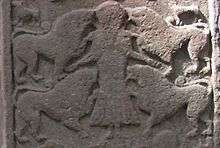
A version of the abduction of Guinevere is associated in local folklore with Meigle in Scotland, known for its carved Pictish stones. One of the stones, now in the Meigle Sculptured Stone Museum, is said to depict Vanora, the local name for Guinevere.[20] She is said to have been abducted by King Modred (Mordred). When she is eventually returned to Arthur, he has her condemned to death for infidelity and orders that she be torn to pieces by wild beasts, an event said to be depicted on Meigle Stone 2 (Queen Venora's Stone).[20] This stone was one of two that originally stood near a mound that is identified as Vanora's grave.[20]
The 14th-century Welsh poet Dafydd ap Gwilym alludes to Guinevere's abduction in two of his poems. In the German tale Diu Crône, Guinevere's own brother Gotegrim kidnaps her and intends to kill her for refusing to marry Gasozein, who claims to be her rightful husband.
Medievalist Roger Sherman Loomis suggested that this motif shows that "she had inherited the role of a Celtic Persephone" (from the Greek mythology).[21] All of these similar tales of abduction by another suitor – and this allegory includes Lancelot, who whisks her away when she is condemned to burn at the stake for their adultery – are demonstrative of a recurring 'Hades-snatches-Persephone' theme, positing that Guinevere is similar to the Otherworld bride Étaín, who Midir, king of the Underworld, carries off from her earthly life after she has forgotten her past.[22]
French-inspired tradition

In French chivalric romances and the later works based on them, including Thomas Malory's Le Morte d'Arthur, Guinevere is the daughter of King Leodegrance, who had served Arthur's father Uther Pendragon and was entrusted with the Round Table after Pendragon's death. In these histories, Leodegrance's kingdom typically lies near the Breton city of Carhaise (the modern Carhaix-Plouguer). In the fields to the south and east of Carhaise, Arthur defends Leodegrance by defeating Rience, which leads to his meeting and marriage with Guinevere. This version of the legend has Guinevere betrothed to Arthur early in his career, while he was garnering support. When Lancelot arrives later, she is instantly smitten, and they have an affair that in the end leads to Arthur's fall.
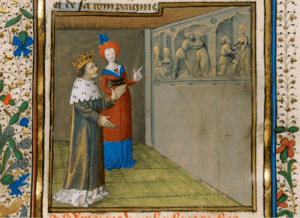
Their affair is eventually exposed by Guinevere's sorceress enemy Morgan le Fay and two of King Lot's sons, Agravain and Mordred, and Lancelot escapes while Arthur reluctantly sentences his wife to be burned at the stake. Knowing Lancelot and his family would try to stop the execution, Arthur sends many of his knights to defend the pyre, though Gawain refuses to participate. Lancelot arrives with his kinsmen and followers and rescues the queen. Gawain's brothers Gaheris and Gareth are killed in the battle (among others, including fellow Knights of the Round Aglovale, Segwarides and Tor), sending Gawain into a rage so great that he pressures Arthur into a direct confrontation with Lancelot.
When Arthur goes to France to fight Lancelot, he leaves Guinevere in the care of Mordred, who plans to marry the queen himself and take Arthur's throne. In some versions of the tale, Guinevere assents to Mordred's proposal; in others, she hides in the Tower of London and later takes refuge in a nun convent at Almesbury. Hearing of the treachery, Arthur returns to Britain and slays Mordred at Camlann, but his wounds are so severe that he is taken to the isle of Avalon by Morgan. Guinevere meets Lancelot one last time, then returns to the convent where she spends the remainder of her life.[23]
In modern culture

Modern adaptations of Arthurian legend vary greatly in their depiction of Guinevere, largely because certain aspects of her story must be fleshed out by the modern author. In spite of her iconic doomed romance with Lancelot, a number of modern reinterpretations portray her as being manipulated into her affair with Lancelot (usually by Morgan le Fay or Nimue), with Arthur being her rightful true love. Others present her love for Lancelot as stemming from a relationship that existed prior to her arranged marriage to Arthur.
- In Marion Zimmer Bradley's The Mists of Avalon, Gwenhwyfar is brought up by a cold, unloving father, which leaves her with a deep inferiority complex and intense agoraphobia. Failing to produce an heir and unable to be with the love of her life, Lancelot, she falls into a deep depression and – hoping for salvation – becomes an increasingly fanatical Christian. Bradley's version is notable for popularizing the Welsh spelling, which many subsequent writers have adopted.
- Lavinia Collins's Guinevere is a historical romance trilogy dealing with Guinevere's marriage to Arthur and the subsequent development of her relationship with Lancelot. Along with typical themes of the romance genre, this adaptation also deals with concepts of magic and religion and builds on Collins's reading of Le Morte d'Arthur.[24]
- In the television series Merlin, Guinevere (called "Gwen" by most of the characters) is portrayed by Angel Coulby and is shown as the daughter of a blacksmith and maid to Morgana along with being her best friend. Elyan the White is portrayed as her brother, and, eventually, one of Arthur's knights. At first, Guinevere is implied as the love interest of Merlin (who is far younger in the series than in usual tales) and is also shown as having an attraction to Lancelot. However in this version of the story, Guinevere's true love is Arthur. Gwen and Arthur marry, despite Uther's and Morgana's attempts to keep them apart. Following Arthur's death, Gwen herself becomes Queen of Camelot.[25]
- Guinevere is a supporting character in Gerald Morris' The Squire's Tales. She starts the series as King Arthur's newly-wedded queen and ends it as Sister Arthur, peacefully living in a convent after Arthur's departure.
- Guinevere is a central character in the Broadway musical Camelot, in which she was initially portrayed by Julie Andrews, then Sally Ann Howes. Vanessa Redgrave appeared in the film version of the musical.
- Guinevere appears in the animated series King Arthur's Disasters, where she is voiced by Morwenna Banks.
- In the television series Guinevere Jones, Guinevere is reincarnated into the main protagonist Gwen Jones portrayed by Tamara Hope.
- In the film King Arthur, Guinevere, played by British actress Keira Knightley, is depicted as a Pictish princess in captivity of a Roman noble family in the far north of Britain. Arthur, charged by Bishop Germanus with escorting the family to safety in light of an impending Saxon invasion, discovers her captivity and liberates her. While traveling back to Roman territory, she introduces Arthur to Merlin who attempts to persuade Arthur to lead the Picts (called Woads in the film) to battle the Saxon army. Once back in Roman territory, their relationship culminates in a brief romance, after which Arthur decides to remain at the Roman outpost to fight the Saxons at Hadrian's Wall while his knights return to Rome. In the climactic Battle of Badon Hill, Guinevere leads a Pictish detachment of archers against the first wave of Saxon invaders, and is nearly killed in close-combat before being rescued by Lancelot. Following the battle, Arthur and Guinevere are married by Merlin in a ceremony at Stonehenge.
- In the television series Camelot, Guinevere is depicted by Tamsin Egerton. An ambitious and strong-willed woman, she is a great support to Arthur and they develop a strong undeniable attraction. However, she is married to Leontes, one of Arthur's most loyal knights, which frustrates their relationship.
- Guinevere appears in ABC's television series Once Upon a Time, played by actress Joana Metrass. This version of Guinevere is portrayed with a noticeable Castilian accent.
- Bernard Cornwell's Arthurian series of novels The Warlord Chronicles depicts Guinevere as the princess of Henis Wyren in North Wales. She is a devoted follower of the Ancient Egyptian goddess Isis. She has ambitions of becoming queen of Dumnonia and weds Arthur, who is the illegitimate son of Uther Pendragon in these novels. The character is fiercely anti-Christian.
- In the TV show Legends of Tomorrow episode Camelot/3000, Guinevere is portrayed by Canadian actress Elyse Levesque.[26] In the episode, she is a knight who became queen because of her loyalty to Merlin. In response to Sara letting her know of her affection for Guinevere; Sara Lance felt attraction to her, and after Merlin, who was actually Stargirl, confessed her love to King Arthur, she and Sara shared a kiss.
- In the Deverry Cycle book Darkspell, the character of Gweniver is a warrior priestess sworn to the Goddess of the Moon in Her Darktime, also known as She of The Sword-Struck Heart. An inspirational warleader, Gweniver is a berserker in combat.
- In the American original version of the animated series Princess Gwenevere and the Jewel Riders, Gwenevere (Gwen) is the show's titular main heroine and protagonist, a daughter of Queen Anya and King Jared from the royal family of the magical kingdom of Avalon. As the series begins, she takes up the sacred Sun Stone and bonds with the flying unicorn named Sunstar to lead the all-girl Jewel Riders to rescue her mentor Merlin and defeat the witches Lady Kale (Gwen's evil aunt) and Morgana who want to rule Avalon. Gwenevere was renamed Starla for the show's international version, Starla and the Jewel Riders.
See also
References
- ↑ Google Ngram search for common spellings
- ↑ Schrijver, Peter (1995). Studies in British Celtic Historical Phonology. Rodopi. pp. 249–250. ISBN 9051838204.
- ↑ Hamp, Eric P. (1996). "Varia: 1. 1 sál m. '(eau de) mer'; 2. 1 sed 'cerf'; 3. slabar; 4. slice 'coquille'; 5. ta- 'obtenir, trouver, pouvoir (féad-<ét-)'; 6. 1 tadg 'poète', 1 tál 'asciam'; 7. Irish tarr, torrach; 8. tinaid; 9. tindabrad, Findabair; 10. 1 úall, úabar, úais; 11. *uern~?". Études Celtiques. 32: 87–90.
- ↑ Koch, John T. (2006). Celtic culture: a historical encyclopedia. Abc-clio. p. 861. ISBN 9781851094400.
- ↑ Dictionary of the Irish Language (ed. E G Quin et al., Royal Irish Academy, Dublin 1913-76; Letter S, Column 205, electronic version at http://www.DIL.ie)
- ↑ Richards, Melville, "Arthurian Onomastics", in: Transactions of the Honourable Society of Cymmrodorion, vol. 2, 1969, p. 257.
- ↑ "Cleveland Evans: Jennifer went from 'strange' to popular". Omaha.
- ↑ Bromwich, Rachel (2006). Trioedd Ynys Prydein: The Triads of the Island of Britain (3 ed.). University of Wales Press. p. 154. ISBN 978-0708313862.
- ↑ Noble, Peter (1972). "The Character of Guinevere in the Arthurian Romances of Chretien de Troyes". The Modern Language Review. 67 (3): 524–535. doi:10.2307/3726121. ISSN 0026-7937.
- ↑ Walters, Lori (1996). Lancelot and Guinevere: a casebook. Routledge. p. 295. ISBN 0-8153-0653-9.
- ↑ Mediavilla, Cindy (1999). Arthurian Fiction: An Annotated Bibliography. Scarecrow Press. ISBN 978-0-8108-3644-0. , page 37
- ↑ Rhys, John, Studies in the Arthurian Legend, Clarendon Press, 1891, p. 49
- ↑ Baron Hallam Tennyson Tennyson, Baron Alfred Tennyson Tennyson (1908). Works of Tennyson, Volume 5. p. 506.
- ↑ Wilentz, Abigail (2009). Relationship Devotional: 365 Lessons to Love & Learn. Lancelot and Guinevere: Sterling. p. 215. ISBN 1-4027-5577-5.
- ↑ Christopher W. Bruce (2013). The Arthurian Name Dictionary. p. 243. Routledge
- ↑ Rodway, Simon, Dating Medieval Welsh Literature: Evidence from the Verbal System. CMCS Publications, Aberystwyth, 2013, p. 16; pp. 168-170.
- ↑ "Caradoc of Llangarfan: The Life of Gildas". Fordham University Medieval Sourcebook. Fordham University. Retrieved 9 April 2016.
- ↑ Bruce, Christopher W. (1999). The Arthurian Name Dictionary. Taylor & Francis. ISBN 978-0-8153-2865-0. , page 355
- ↑ (de Troyes), Chrétien (1990). Lancelot, or, The Knight of the Cart. University of Georgia Press. ISBN 0-8203-1213-4.
- 1 2 3 Meigle Sculptured Stone Museum at Historic Scotland
- ↑ Loomis, Roger Sherman (2000). The Development of Arthurian Romance. Dover Publications. ISBN 978-0-486-40955-9.
- ↑ Thomas, Neil (2002). Diu Crône and the medieval Arthurian cycle. D.S.Brewer. ISBN 0-85991-636-7.
- ↑ Roberts, Sandye; Jones, Arthur (2010). Divine Intervention II: A Guide to Twin Flames, Soul Mates, and Kindred Spirits. AuthorHouse. ISBN 978-1-4567-1255-6. , page=52
- ↑ Collins, Lavinia. "The Warrior Queen (The Guinevere Trilogy)".
- ↑ "Merlin". Merlin TV Series Fansite. Retrieved 5 April 2012.
- ↑ Abrams, Natalie (December 12, 2016). "Legends of Tomorrow books The Originals alum". Entertainment Weekly.
Bibliography
- Borchardt, Alice (2001). The Dragon Queen (Tales of Guinevere). Del Rey. ISBN 0-345-44399-3.
- Bromwich, Rachel (1963). Trioedd Ynys Prydein: The Triads of the Island of Britain. University of Wales Press. ISBN 0-7083-1386-8.
- Chappell, Gavin (2012). The Rape of Guinevere. Schlock! Publications. ASIN B0070O5OFU.
- Coghlan, Ronan (1991). Encyclopaedia of Arthurian Legends. Element Books. ISBN 978-1-85230-199-6.
- Goodrich, Norma Lorre (1992). Guinevere. HarperPerennial. ISBN 9780060922924.
- Hopkins, Andrea (2004). The Book of Guinevere: Legendary Queen of Camelot. Saraband. ISBN 9781887354042.
- Korrel, Peter (1984). An Arthurian Triangle: A Study of the Origin, Development, and Characterization of Arthur, Guinevere, and Modred. Brill Archive. ISBN 9004072721.
- Machen, Arthur (1987). Guinevere and Lancelot and Others. Purple Mouth Pr. ISBN 978-0-9603300-2-7.
- Malory, Thomas (1953). Lancelot & Guinevere. Folio Society.
- McKenzie, Nancy (2009). Guinevere's Gamble. Random House Children's Books. ISBN 9780375843464.
- McKenzie, Nancy (2011). Guinevere's Gift. Random House LLC. ISBN 9780440240204.
- McKenzie, Nancy (2002). Queen of Camelot. Del Rey. ISBN 978-0-345-44587-2.
- Miles, Rosalind (2000). Guenevere, Queen of the Summer Country. Broadway. ISBN 978-0-609-80650-0.
- Newman, Sharan (1997). The Chessboard Queen: A Story of Guinevere. Macmillan. ISBN 9780312863913.
- Newman, Sharan (1996). Guinevere. Macmillan. ISBN 9780312862336.
- Newman, Sharan (1998). Guinevere Evermore. Tom Doherty Associates. ISBN 9780312866419.
- Noble, Peter (1972). "The Character of Guinevere in the Arthurian Romances of Chretien de Troyes". The Modern Language Review. 67 (3): 524. doi:10.2307/3726121. ISSN 0026-7937.
- San Souci, Robert D. (1996). Young Guinevere (A Dell Picture Yearling). Doubleday. ISBN 978-0-440-41291-5.
- Sterne, Emma Gelders (2002). King Arthur and the Knights of the Round Table. Golden Books. ISBN 978-0-307-10432-8.
- Tennyson, Alfred Tennyson (2010). Guinevere & Arthur; adapted from Tennyson's Idylls of the King. Nabu Press. ISBN 978-1-171-81628-7.
- Walters, Lori (2001). Lancelot and Guinevere: A Casebook. Routledge. ISBN 9780415939119.
- Webster, Kenneth Grant Tremayne (1951). Guinevere: A study of her abductions. Turtle Press.
- Woolley, Persia (2010). Child of the Northern Spring: Book One of the Guinevere Trilogy. Sourcebooks Landmark. ISBN 978-1-4022-4522-0.
- Woolley, Persia (2011). Guinevere, the Legend in Autumn. Sourcebooks, Incorporated. ISBN 9781402246432.
External links
| Wikimedia Commons has media related to Guinevere. |